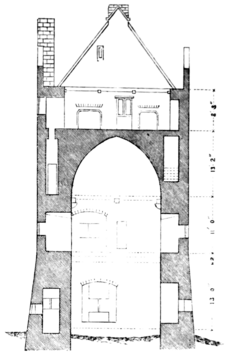a castle at this spot seems to have sprung from the desire of the Archbishops of Tuam to suppress the bishopric of Annadown,
which was several times extinguished and revived; and in 1252, Florence, Archbishop of Tuam, obtained from Henry III. a confirmation of a papal bull for the suppression of the see, on condition that a castle should be built on the church lands; the bishopric, however, continued, with short intervals, to exist; but in 1421 the last bishop who held the see was appointed, and it is to him that the erection of the present castle is probably due.[1]
Kilmallock is an interesting town to the antiquary, being full of ruins of old buildings, but the most important of these are ecclesiastical, and some others belong to the Elizabethan period. There are two gatehouses of the fifteenth century, but in a bad state, and not very remarkable; one of them is inhabited. In the principal street is a row of Elizabethan town houses of good character, worthy of the attention of architects for modern street-houses.
Fanstown Castle, near Kilmallock, is another tower-house of the fifteenth or early part of the sixteenth century, with two vaults and three stories over the upper one, six in all; with a fireplace and garderobe on each floor, and two fireplaces in the upper chamber. There are bartizans at two corners of the chief apartment over the vault, but not at the top of the tower; these are furnished with loopholes, and small round holes for muskets.
Ballygruffan Castle, near Bruff, consists of the ruins of a large fortified tower of the sixteenth century, with a square tower in the centre, which is more perfect than the rest. There are bartizans both to the tower and to the outer walls;
- ↑ I am indebted to G. M. Hills, Esq. Architect, for the drawings and description of this castle, which I was prevented from visiting personally.


